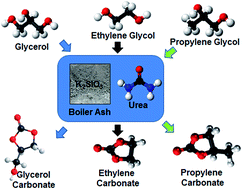Versatile boiler ash containing potassium silicate for the synthesis of organic carbonates†
Abstract
In this study, boiler ash containing potassium silicate (BA 900) and potassium silicate (K2SiO3) were proven to be feasible Lewis acid catalysts for the synthesis of different organic carbonates (glycerol carbonate, ethylene carbonate, and propylene carbonate) from different polyol (glycerol, ethylene glycol, and propylene glycol) feedstocks. In addition, the developed catalytic reaction has the ability to produce propylene carbonate at milder reaction temperatures. BA 900 and K2SiO3 were reusable for three consecutive reaction cycles without the loss of activity. The reusable characteristics of catalysts were confirmed through several characterisation techniques, i.e. XRD, FTIR, XRF, N2 physisorption, FESEM-EDX, and Hammett test. All organic carbonates synthesised had a similar synthetic mechanistic pathway, which involved decomposition of intermediate carbamates into their respective carbonates.


 Please wait while we load your content...
Please wait while we load your content...